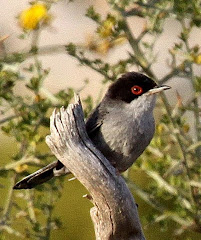February 8, 2011:
This drake had been reported here intermittently for the past ten days; when absent it was thought to be at a nearby reservoir. Today, it spent all the time at the furthest, inaccessible part of the lake and could not be viewed closer than 250 metres.

Ring-necked Ducks nest in northern North America and Canada and are strong migrants wintering in the south of that continent. Each year a few vagrants arrive in Britain, one bird (possibly the same one) was in seen in the area last year.

Present with it were about 15 Pochard and a similar number of Tufted Duck, several Mallard, two Goldeneye, a Great Crested Grebe and numerous Coot. It kept in loose association with the Pochard and particularly with one female with which it spent much time diving.

[Above, the drake second from left, with the much larger Mallard and slightly larger Pochard]

[Here with its diving companion, the female Pochard]
In appearance and plumage it exibited all the typical characters of the drake: a distinctly domed rear portion of its head, a prominent light stripe across its bill with a white band at the base, silvery-grey flanks with a white spur only at the front plus a faint white line running along the top, and markedly S-shaped flank panels.

After a long period of diving during which it seemed mainly to bring up weed, it did a little flapping and preening before drifting away into the reed bed to sleep.




















.jpg)



